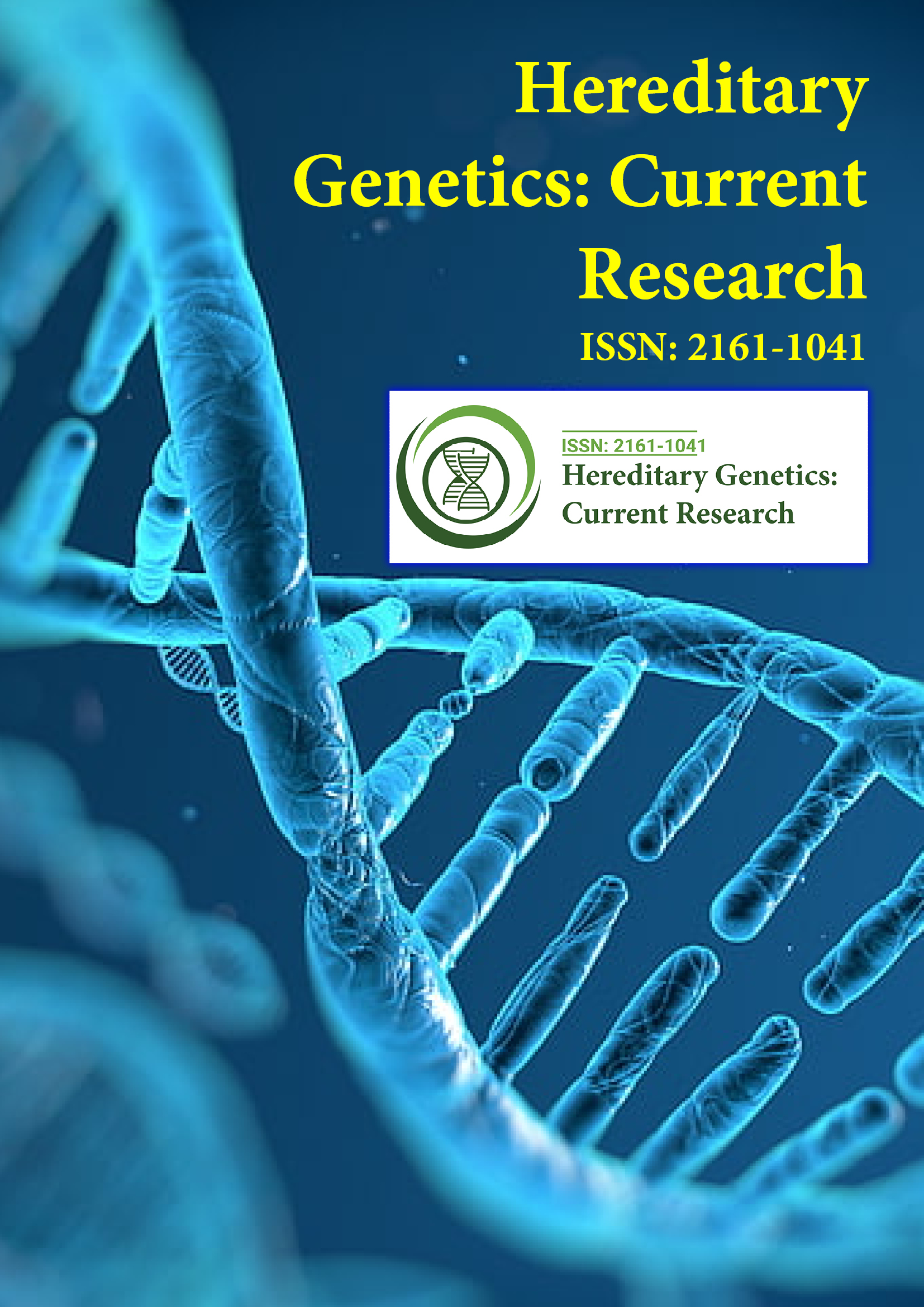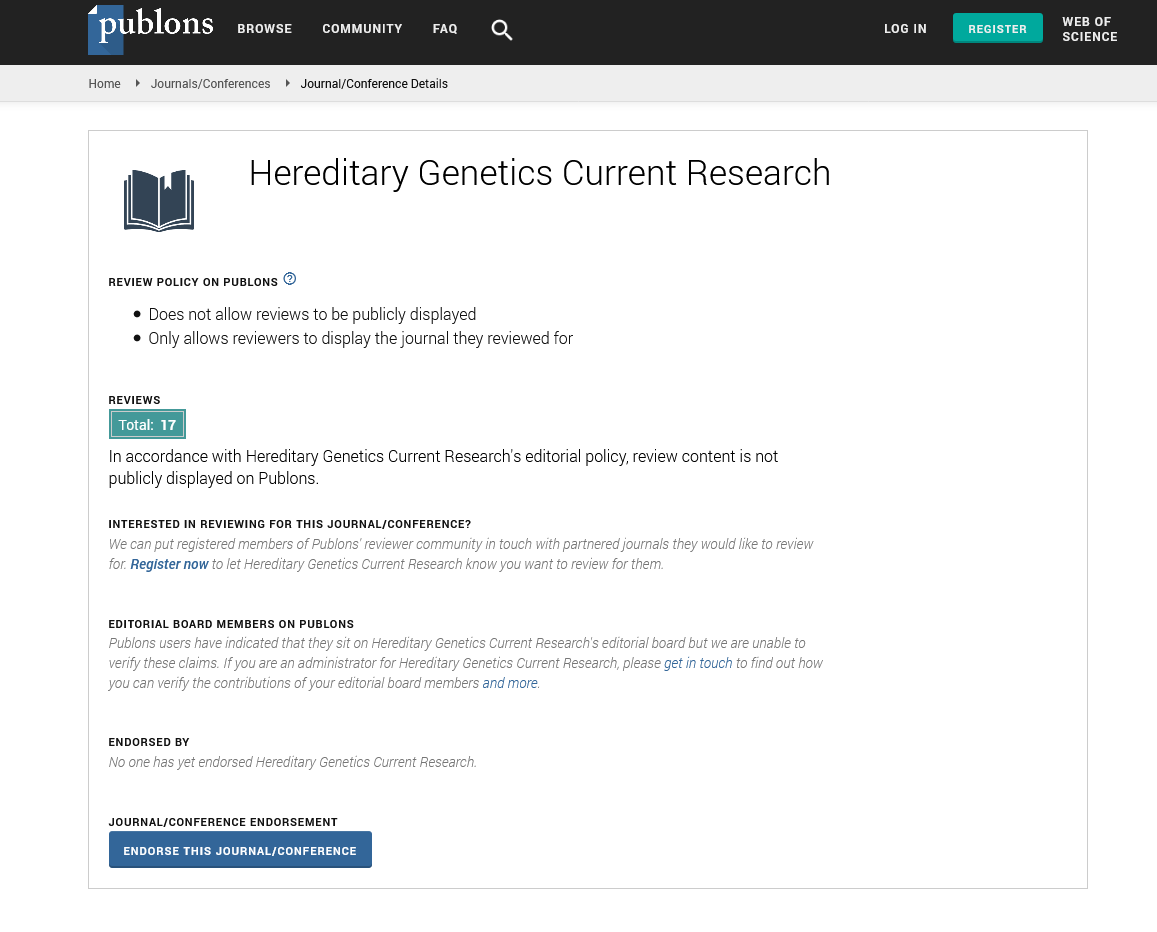Indexed In
- Open J Gate
- Genamics JournalSeek
- CiteFactor
- RefSeek
- Hamdard University
- EBSCO A-Z
- NSD - Norwegian Centre for Research Data
- OCLC- WorldCat
- Publons
- Geneva Foundation for Medical Education and Research
- Euro Pub
- Google Scholar
Useful Links
Share This Page
Journal Flyer

Open Access Journals
- Agri and Aquaculture
- Biochemistry
- Bioinformatics & Systems Biology
- Business & Management
- Chemistry
- Clinical Sciences
- Engineering
- Food & Nutrition
- General Science
- Genetics & Molecular Biology
- Immunology & Microbiology
- Medical Sciences
- Neuroscience & Psychology
- Nursing & Health Care
- Pharmaceutical Sciences
Commentary - (2025) Volume 14, Issue 1
Heritability and Clinical Implications of Phenotypic and Genetic Factors in Bipolar Disorder: Findings from Family-Based Studies
Knowles Khullar*Received: 26-Feb-2025, Manuscript No. HGCR-25-28183; Editor assigned: 28-Feb-2025, Pre QC No. HGCR-25-28183 (PQ); Reviewed: 14-Mar-2025, QC No. HGCR-25-28183; Revised: 21-Mar-2025, Manuscript No. HGCR-25-28183 (R); Published: 28-Mar-2025, DOI: 10.35248/2161-1041.25.14.299
Description
Bipolar Disorder (BD) is a complex psychiatric condition characterized by extreme mood swings, including episodes of mania, hypomania and depression. It has long been recognized as having a strong hereditary component, though the exact mechanisms by which genetics contribute to the disorder remain largely unclear. This manuscript discusses the heritability of bipolar disorder, emphasizing the phenotypic and genetic factors identified in family studies, along with the clinical implications for diagnosis and treatment. Bipolar disorder shows a significant familial aggregation, with first-degree relatives of affected individuals being at a markedly increased risk of developing the disorder. Twin studies have demonstrated a heritability estimate for BD ranging from 60% to 85%, indicating that genetic factors play a substantial role in its development. The recurrence of BD in families points to the existence of specific genetic variants that may predispose individuals to this condition. However, the identification of these genetic factors remains challenging due to the complex nature of the disorder, which is influenced by multiple genes and environmental interactions.
The phenotypic expression of bipolar disorder varies widely among individuals. While mood episodes are central to the diagnosis, the age of onset, course of the illness and associated clinical features such as psychotic symptoms or substance abuse, can vary significantly. Family studies are crucial in understanding the clinical heterogeneity of BD. For instance, individuals with a family history of BD tend to experience earlier onset of the disorder, which can influence treatment strategies. Additionally, the type of mood episodes (mania or depression) may differ across generations within a family, highlighting the complex genetic underpinnings of BD. One of the most important aspects of studying bipolar disorder in family samples understands how the disorder manifests across different generations. For example, some studies have found that manic episodes are more common in the parents of individuals with bipolar disorder, while depressive episodes may be more prevalent in subsequent generations. This suggests that there may be genetic variations that predispose individuals to either mania or depression, or that environmental factors in early life may influence the course of the disorder. Genetic studies, including linkage analyses and Genome-Wide Association studies (GWAS), have identified several potential risk loci for bipolar disorder. However, despite extensive research, no single gene has been found to account for the majority of cases of BD. Rather, multiple small-effect variants appear to contribute to the risk, along with gene-environment interactions. Genes involved in neurotransmission, synaptic plasticity and cell signaling have been implicated in the associated with schizophrenia, has been shown to have a role in bipolar disorder, as it influences neuronal development and function.
Family studies have also revealed that the risk of developing BD is higher when both parents are affected, suggesting an additive genetic effect. However, genetic risk does not fully explain the development of the disorder. Environmental factors, including stressful life events, childhood trauma and substance abuse, interact with genetic predisposition to influence the onset and course of bipolar disorder. This gene-environment interaction is central to the understanding of BD and emphasizes the need for comprehensive assessment and intervention strategies that consider both genetic and environmental factors. The clinical implications of these findings are significant. Family studies help clinicians identify individuals who are at high risk for developing bipolar disorder, allowing for early intervention and prevention strategies. For example, individuals with a family history of BD who experience mood disturbances may benefit from more frequent monitoring and early treatment to prevent the full onset of the disorder. Additionally, the identification of specific genetic risk factors for BD may eventually lead to the development of personalized treatments based on an individual's genetic profile. Bipolar disorder is a highly heritable condition with complex phenotypic and genetic factors that vary across individuals and families.
In conclusion, family studies provide valuable insights into the clinical factors that influence the development and course of the disorder, including the role of age of onset, mood episode type and familial patterns of symptom expression. While genetic studies have identified several potential risk genes, the interplay between genetic and environmental factors remains a central challenge in understanding the etiology of BD. As research continues to explore the genetic underpinnings of bipolar disorder, it is likely that more precise diagnostic and treatment strategies will emerge, offering hope for improved outcomes for individuals with this challenging condition.
Citation: Khullar K (2025). Heritability and Clinical Implications of Phenotypic and Genetic Factors in Bipolar Disorder: Findings from Family-Based Studies. Hereditary Genet. 14:299.
Copyright: © 2025 Khullar K. This is an open access article distributed under the terms of the Creative Commons Attribution License, which permits unrestricted use, distribution, and reproduction in any medium, provided the original author and source are credited.

